Its been six years since Ford shuttered its ancient Twin Cities plant in Minnesota, walking away from what seemed to be, back then, a dying market segment.
But the Detroit automaker failed to reckon on what might happen when new product would be injected into the midsize category, General Motors scoring a hit with the likes of its Chevrolet Colorado and GMC Canyon, and Honda hitting the ball out of the park by bringing back its own Ridgeline model.
Ironically, Ford actually launched a new Ranger – but it was intended for just about every market except for North America, the company’s planners convinced they could get potential midsize buyers to make the walk up-market to the bigger F-150. But as it watched its competition rapidly rebuild the old midsize pickup segment – sales growing a hefty 83% since 2014 – Ford realized it needed to get back in the game.
“As transaction prices continued to grow for full-size pickups, we saw an opportunity,” said Todd Eckert, Ford’s Truck Group Marketing manager. “We think this is an opportunity to bring back some of our former Ranger customers and get new buyers.”
(New Ford F-150 Diesel aims to crack the 30-mpg barrier. Click Here for the story.)
The 2019 Ford Ranger isn’t just a downsized F-150. Nor is it just a tweaked version of the midsize pickup sold overseas, company officials revealed during a background briefing on the new truck. Virtually every body panel and a significant portion of what’s underneath the skin has been revised for the North American market. There’s also plenty of infotainment and safety gear meant to appeal to U.S. buyers.
“We’ve touched every exterior panel,” said Max Wolff, who oversaw exterior design, even the rear glass that gets a new pass-through.
Visually, the goal was to give the new truck a tough, albeit modern, appearance. That starts with the steel bumpers and oversized grille – make that two grilles, depending upon which version of the truck you opt for. Wolff said he was aiming to accentuate the width of the truck while giving it a solid, planted feel. That’s enhanced by the “power bulge” in its hood.
But Wolff also aimed to minimize body panel gaps to give the 2019 Ranger a more high tech and refined look, with a steep windshield rake that emphasizes its “athletic and dynamic quality.”
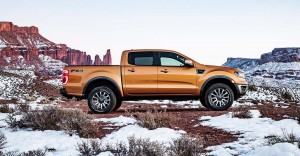
The new Ranger midsize pickup comes in a variety trim levels depending upon what kind of capability is needed.
The new Ranger won’t offer quite the variety of the big F-150, but there will still be three trim levels and a choice of either a Super Cab or Crew Cab, as well as two bed lengths. There’ll even be eight available wheel options.
Inside, a horizontal layout to the instrument panel is also meant to give the new Ranger a sense of width. The reborn truck is anything but the stripped-down, utilitarian offering of the old Ranger line. There’s been a push for more upgraded materials, and the center stack is capped by a large touchscreen, with the navigation package offered with an eight-inch display.
That doesn’t mean Ford has forgotten the utilitarian needs of pickup buyers. Among other things, there’s a waterproof storage bin tucked underneath the second-row seats.
(Click Here for an early look at the new Ford Ranger.)
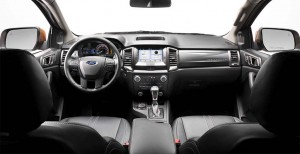
The interior of Ford's Ranger midsize pickup comes with plenty of creature comforts as well as massive touchscreen infotainment display.
The underlying frame of the 2019 Ford Ranger has been heavily modified for the U.S. market, according to Rick Bolt, the chief program engineer, with six box cross members. The truck rides on a Double A-Arm front suspension, with a live axle rear. It also uses heavy-duty monotube shocks.
Ford aims to cover all bases, including the large base of midsize truck buyers who want serious off-road capabilities. There’s an FX-4 package for all trim levels that includes Dana front and rear electronic locking differentials, upgraded tires, still front bump plates and reinforced skid plates, along with a shift-on-the-fly two-speed transfer case.
Across the board the Ranger will be offered with a Terrain Management System that can be set to a variety of different road conditions, such as snow or mud and ruts. Each of the four modes adjusts a range of vehicle settings, such as throttle response and shifts.
“That truly gives an added level of confidence to the driver,” said Brendan Cameron, a development engineer on the project.
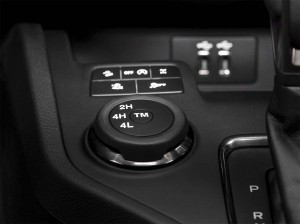
The 2019 Ranger gives the driver several settings in the terrain control giving them plenty of options.
One of the more appealing features that will be offered on the new Ranger is a blind spot monitoring system that can be set to work with trailers of up to 33 feet in length. In fact, the settings for three different trailers can be stored in the system.
Other high-tech features including the Sync3 infotainment system with Apple CarPlay and Android Auto, onboard WiFi and an upgraded B&O audio package. On the safety side, there is pre-collision assist – with automatic emergency braking standard – lane departure warning and lane-keep assist, and active cruise control.
All versions of the 2019 Ford Ranger will be powered by a turbocharged 2.3-liter EcoBoost I-4 engine paired with a Selectshift 10-speed automatic. While Ford isn’t ready to release final numbers, it claims it will take “leadership” in both torque and fuel economy in the midsize pickup segment.
Ford had a solid and loyal base of buyers for the old Ranger. Whether it can lure them back – and win over new customers – is far from certain. While the midsize pickup segment has nearly doubled since hitting bottom, competition has grown fierce. Ford will need to really deliver on performance and fuel economy numbers when they’re released, and pricing will likely have to be quite competitive, as well.
(To see more about the return of the Ford Ranger, Click Here.)
Production is set to begin at the automaker’s Wayne, Michigan assembly plant late next year. (That’s the same facility that will handle the Bronco SUV also set to make a comeback.) Look for the 2019 Ford Ranger to roll into U.S. showrooms early next year.

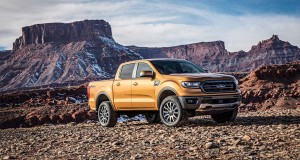
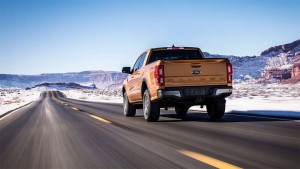
May be the reason Fields is gone. Employees have been begging for the Ranger return for years and there was never a good reason given. Ford was so protective of the F-Series market share, they were afraid Ranger was going to steal sales. Unfortunately, this version is TOO DAMN BIG.